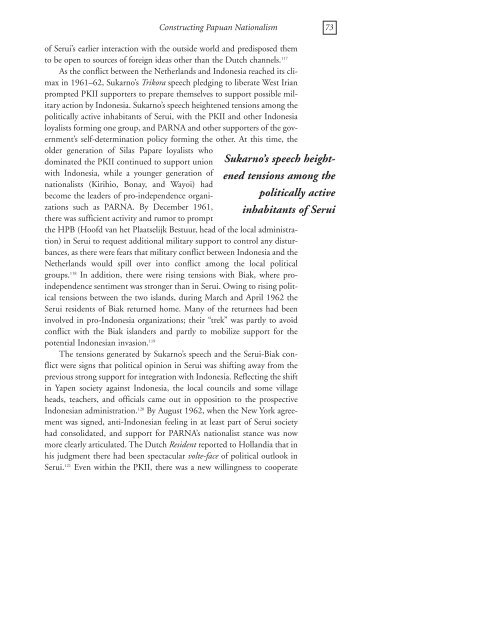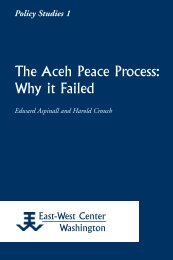Constructing Papuan Nationalism: History, Ethnicity ... - ScholarSpace
Constructing Papuan Nationalism: History, Ethnicity ... - ScholarSpace
Constructing Papuan Nationalism: History, Ethnicity ... - ScholarSpace
- No tags were found...
Create successful ePaper yourself
Turn your PDF publications into a flip-book with our unique Google optimized e-Paper software.
<strong>Constructing</strong> <strong>Papuan</strong> <strong>Nationalism</strong> 73of Serui’s earlier interaction with the outside world and predisposed themto be open to sources of foreign ideas other than the Dutch channels. 117As the conflict between the Netherlands and Indonesia reached its climaxin 1961–62, Sukarno’s Trikora speech pledging to liberate West Irianprompted PKII supporters to prepare themselves to support possible militaryaction by Indonesia. Sukarno’s speech heightened tensions among thepolitically active inhabitants of Serui, with the PKII and other Indonesialoyalists forming one group, and PARNA and other supporters of the government’sself-determination policy forming the other. At this time, theolder generation of Silas Papare loyalists whodominated the PKII continued to support unionwith Indonesia, while a younger generation ofnationalists (Kirihio, Bonay, and Wayoi) hadbecome the leaders of pro-independence organizationssuch as PARNA. By December 1961,there was sufficient activity and rumor to promptthe HPB (Hoofd van het Plaatselijk Bestuur, head of the local administration)in Serui to request additional military support to control any disturbances,as there were fears that military conflict between Indonesia and theNetherlands would spill over into conflict among the local politicalgroups. 118 In addition, there were rising tensions with Biak, where proindependencesentiment was stronger than in Serui. Owing to rising politicaltensions between the two islands, during March and April 1962 theSerui residents of Biak returned home. Many of the returnees had beeninvolved in pro-Indonesia organizations; their “trek” was partly to avoidconflict with the Biak islanders and partly to mobilize support for thepotential Indonesian invasion. 119The tensions generated by Sukarno’s speech and the Serui-Biak conflictwere signs that political opinion in Serui was shifting away from theprevious strong support for integration with Indonesia. Reflecting the shiftin Yapen society against Indonesia, the local councils and some villageheads, teachers, and officials came out in opposition to the prospectiveIndonesian administration. 120 By August 1962, when the New York agreementwas signed, anti-Indonesian feeling in at least part of Serui societyhad consolidated, and support for PARNA’s nationalist stance was nowmore clearly articulated. The Dutch Resident reported to Hollandia that inhis judgment there had been spectacular volte-face of political outlook inSerui. 121 Even within the PKII, there was a new willingness to cooperateSukarno’s speech heightenedtensions among thepolitically activeinhabitants of Serui
















